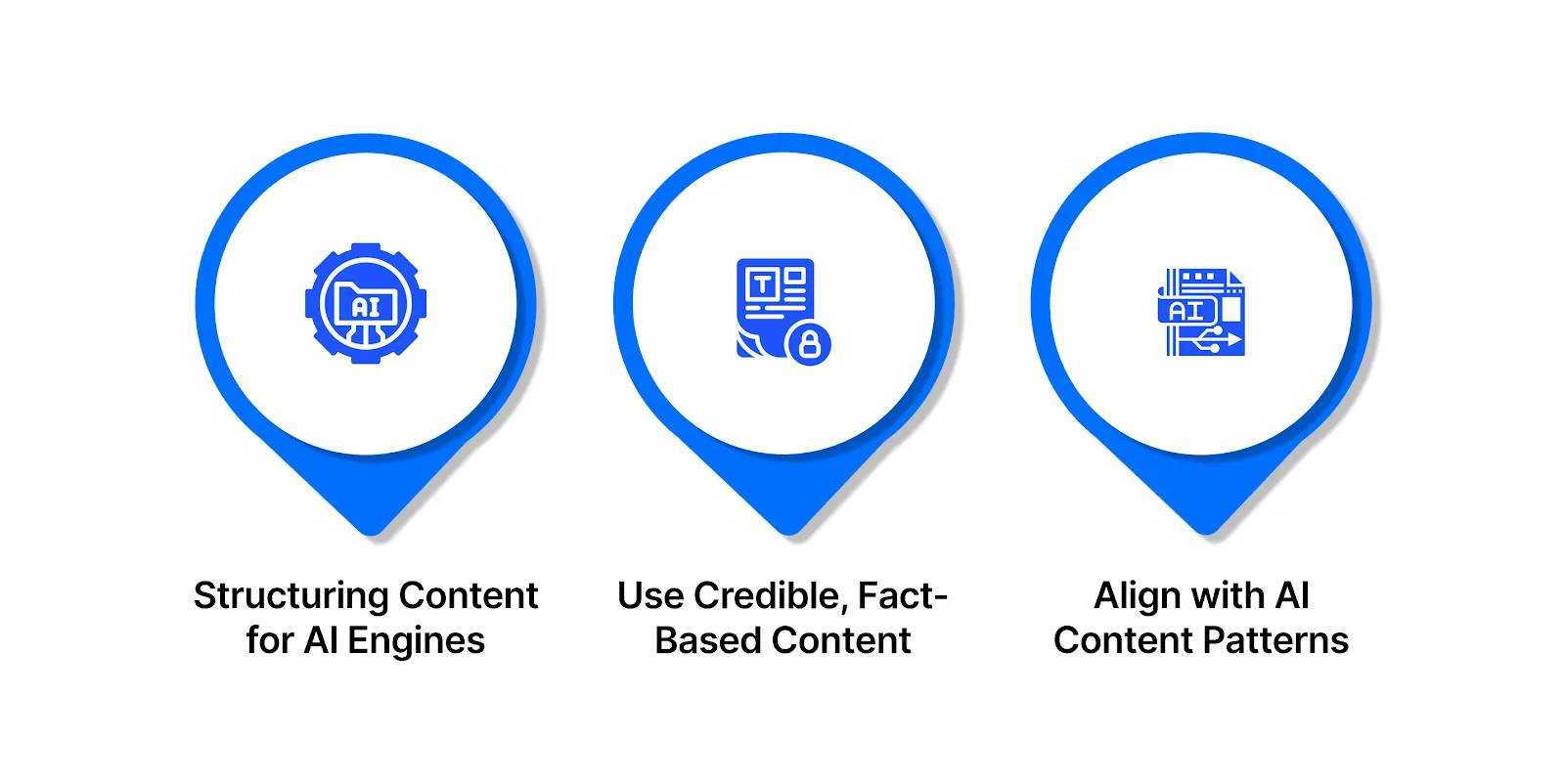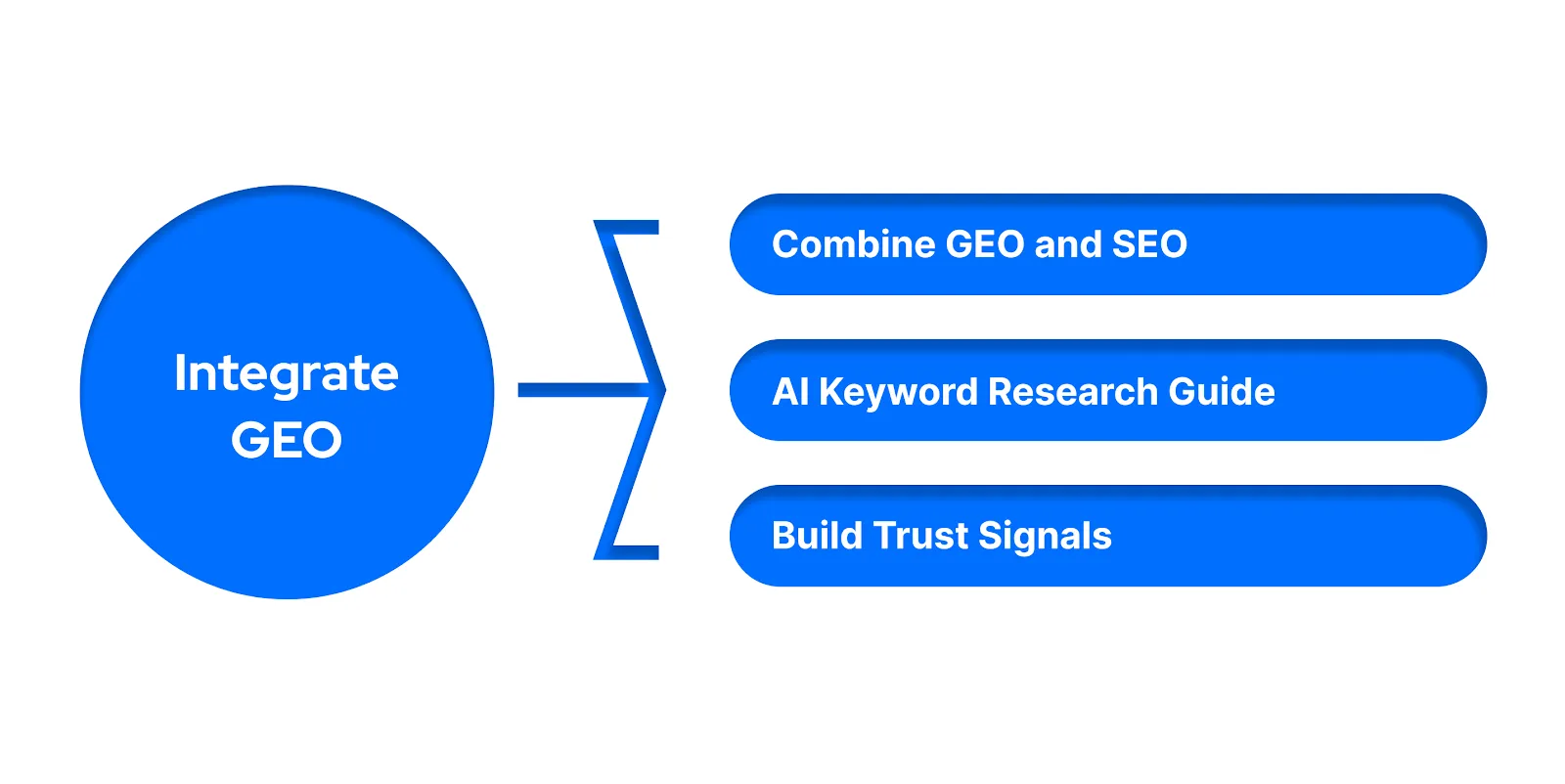TL;DR
- Generative Engine Optimization (GEO) is the practice of optimizing content to be cited and summarized by AI search engines like ChatGPT and Perplexity.
- GEO differs from traditional SEO by focusing on visibility in AI-generated answers rather than only Google rankings.
- To succeed with GEO, content should be highly structured, fact-based, and optimized for AI parsing and citation.
- Writing clear, concise, and self-contained sentences increases the chances of your content being used in AI responses.
- Combining GEO and SEO strategies ensures your brand appears in both traditional and AI-driven searches.
If you're a growth marketer or B2B SaaS leader, chances are your search strategy feels less effective lately. Google traffic is down, top-of-funnel content isn’t converting, and AI tools are answering user questions instantly, no clicks or site visits required.
Search behavior has changed. Instead of scrolling through ten blue links, users now type a question into an AI tool and move on with a summary.
If your content isn’t showing up in those AI-generated answers, you're losing visibility where it matters most.
Generative Engine Optimization (GEO) helps fix that. It’s about structuring your content so AI engines can easily understand, cite, and summarize it.
By 2026, Gartner estimates that 25% of all search queries will shift from traditional search engines to AI-driven interfaces. That means organic search traffic could drop by up to 50% if your strategy doesn't include GEO. To stay visible, you need to adapt your content to meet AI's preferences.
This blog covers what GEO is, how it differs from traditional SEO, and how you can apply it using tools like Gushwork’s GEO suite.
What Is GEO?
GEO stands for Generative Engine Optimization. It's the process of optimizing your content to get cited, referenced, or summarized by AI tools like ChatGPT, Claude, and Perplexity.
Unlike traditional SEO, which focuses on ranking in Google search results, GEO is about being included in AI-generated responses. Instead of driving clicks, you're aiming to get your content pulled directly into an AI's answer box.
When done right, GEO can increase your online visibility by up to 40%, especially for information-heavy topics where AI engines tend to summarize from credible, well-structured sources.
Now that you know what GEO is, let’s understand why it’s becoming critical for marketers, especially as AI becomes the new front door to online discovery.
Why GEO Matters in an AI-Driven Marketing Strategy
68% of marketers are already using AI tools like ChatGPT to generate content and brainstorm ideas. As these tools grow more popular, users rely on them for quick, accurate answers.
This shift in behavior means people are getting what they need without clicking through to websites. Traditional SEO can’t fully support this change. GEO ensures your content doesn’t get left behind.
GEO focuses on:
- Making your content easy for AI to parse and understand
- Including facts, citations, and a clear structure
- Matching the conversational and summary-first tone of AI results
If you're not adapting your content, AI might summarize someone else's site instead of yours.
Still relying on SEO alone? It’s time to rethink that. Let’s break down how GEO stacks up against traditional SEO, and why combining both matters more than ever.
GEO vs. SEO: What’s the Difference?
SEO and SEO both aim to improve visibility, but they serve different search behaviors. While SEO focuses on helping your site rank in traditional search engines, GEO is all about getting your content featured in AI-generated answers.
GEO is effective because it meets users where they’re headed, AI engines. It helps your brand stay visible, credible, and relevant in a world that’s shifting away from link-based results.
And the shift isn’t just theoretical. Marketers are already discussing it in public forums like Reddit, where one top-voted response in a thread comparing GEO and SEO put it simply:
“Make good content that is authentic and has value for your audience, without trying to game the system or take shortcuts… Use best practices for readability, linking, accessibility, performance, and semantic structure—whether humans or machines are reading it. And ‘voila’, you are ‘optimized’.”
This sums up the heart of both strategies: good content, structured well, served with clarity. GEO just takes it a step further by tailoring that same content to how AI interprets and summarizes it.
So, how do you actually make your content GEO-ready? The good news is, it’s more about smart structuring and relevance than reinventing everything from scratch.
How Generative Engine Optimization (GEO) Works

To show up in AI-generated answers, your content needs to be easy for generative engines to read, trust, and summarize. That means writing not just for people, but also for machines that prioritize structure, clarity, and reliability. GEO helps you adapt your content so it’s more likely to be referenced in AI summaries and response boxes.
1. Structuring Content for AI Engines
Generative engines scan content differently from traditional search bots. Instead of just looking at keywords, they look for structure and context. To meet these expectations:
- Use a conversational tone that feels natural and human
- Format answers in Q&A style to match how users ask questions
- Break ideas into bulleted or numbered lists for quick extraction
Behind the scenes, many generative systems are designed to extract only clearly defined, self-contained statements. That means each fact or claim should stand on its own, ideally as a single, declarative sentence. Avoid burying insights in long, complex paragraphs. Well-formatted FAQs, short callouts, and clearly labeled sections all help models extract what matters.
2. Use Credible, Fact-Based Content
AI engines prioritize trustworthy sources. If your content includes cited data, mentions of authoritative sources, or statistics from recognized organizations, it’s far more likely to be pulled into a generated answer.
- Reference research studies, industry reports, and real data
- Avoid vague claims and stick to clearly supported insights
- Maintain a neutral, informative tone that reads like expert advice
- Keep your language clear and direct.
- Shorter, high-signal statements tend to perform better.
Importantly, generative engines tend to ignore metadata, footnotes, or content hidden in tooltips or sidebars. Instead, they rely heavily on what’s written in the main visible body of the page. For best results, make sure your key facts and stats are embedded directly in the core content, where they can be seen, indexed, and cited.
3. Align with AI Content Patterns
Generative engines prefer consistency. That includes the use of:
- Proper heading hierarchy (H2s, H3s, etc.)
- Clear metadata (titles, descriptions, structured tags)
- Logical content flow that builds from problem to solution
Additionally, engines often favor content that mirrors natural question-and-answer phrasing. Think of how users might prompt an AI with phrases like “What is X?” or “How does Y work?”—then answer in a format that matches those queries directly.
This structure makes it easier for AI tools like ChatGPT and Perplexity to extract parts of your content and present them as direct answers, even without linking to the original page.
Following best practices is great, but here’s why it truly matters: AI-driven tools are already influencing buying decisions, and brands ignoring GEO are losing ground fast.
Why Brands Should Care Now
AI tools are quickly becoming the first stop for users looking for answers. If your content isn’t showing up in these generated results, you’re already behind.
1. Users Are Already Switching to AI Tools
People are using ChatGPT, Perplexity, and Gemini to research products, compare solutions, and make decisions, without ever clicking a traditional search link. In fact, 8% of Americans now use ChatGPT as their primary search engine, according to an Evercore survey. That number is only expected to grow.
If your brand doesn’t appear in AI-generated answers, you risk missing out on entire segments of your audience.
2. GEO Boosts Brand Authority
When an AI tool cites your brand, it sends a strong trust signal to users. That mention can influence buying decisions, shape brand perception, and drive recognition in your industry.
3. Quality Data Is the New SEO
GEO encourages clear, structured, fact-based content. It’s not about stuffing in keywords, it’s about writing answers that AI can trust and reuse.
Clean formatting, strong sources, and concise explanations make your content easier to feature in voice search, chat results, and AI summaries, all while improving the overall reading experience.
If you’re ready to get started, don’t worry, you don’t need to throw out your existing strategy. Here’s how you can integrate GEO into your current marketing workflow without missing a beat.
How to Integrate GEO Into Your Marketing Strategy?

You don’t need to start from scratch to make your content GEO-friendly. The smartest approach blends GEO with traditional SEO so your brand shows up in both search results and AI-generated answers.
1. Combine GEO + SEO for Better Results
GEO doesn’t replace SEO, they work better together:
- Use SEO to rank on Google and drive long-term traffic
- Use GEO to get mentioned in AI tools like ChatGPT and Perplexity
This dual approach helps you stay visible across all search environments.
2. Conduct AI-Focused Keyword Research
Don’t just chase keywords. Pay attention to how users ask questions in tools like ChatGPT.
Use tools like Gushwork to find the conversational queries and long-tail prompts that AI engines prioritize when generating answers.
3. Build Trust Signals
AI engines are picky about what content they trust. To improve your chances of being cited:
- Add author bios to show expertise
- Include real sources and references
- Use entity markup and structured headings
Putting GEO into action is only half the equation. To make it work long-term, you need to track the right metrics, especially since most analytics tools don’t show what’s happening inside AI platforms.
Measuring GEO Performance

Once you start optimizing for generative engines, you need the right metrics to know what’s working. Traditional tools miss most of what happens inside AI platforms, so it’s time to update your measurement stack.
1. What to Track
Focus on performance signals that actually reflect GEO success:
- Mentions in ChatGPT, Claude, and Perplexity
- Impressions and views from AI-powered tools
- Featured snippets, citations, and direct answers
These indicators show whether your content is being recognized and reused by AI engines.
2. Use Tools That Measure Generative Visibility
Most web analytics platforms won’t tell you if ChatGPT is quoting your blog or if Perplexity is using your guide. That’s where Gushwork’s AI Visibility Suite comes in. It helps you monitor:
- How often is your content cited across AI tools
- Which pages or assets are showing up most frequently
- Trends in AI-driven mentions over time
3. Monitor Brand Mentions and Authority
Keep track of how AI platforms are referencing your brand. Combine this with your usual SEO indicators, like backlinks, domain authority, and referral sources, to get a complete picture of visibility and trust.
The more your content is cited by AI engines, the stronger your brand presence becomes in the evolving world of search.
Start GEO Optimization Today
Generative Engine Optimization (GEO) isn’t just a trend; it’s how modern visibility works in an AI-first search environment. Traditional SEO alone won’t get your brand cited, summarized, or recommended by LLMs. To show up where decisions are being made, your content needs to be structured, accessible, and AI-friendly.
That’s exactly what Gushwork’s AI Optimization Suite is designed to support. Whether you’re starting with a visibility check or scaling a full AI search strategy, our tools work together to make your content stand out in LLM-powered engines:
- AI Search Grader helps you benchmark visibility and sentiment across platforms like ChatGPT and Claude.
- LLMs.txt Generator gives you control over what content AI models see and prioritize.
- AI Visibility Suite tracks how AI systems cite your brand, highlights query insights, and keeps your content synced in real-time.
Book a free appointment with our team to explore how your brand can rank, appear, and get cited in AI search results.




















.webp)








.webp)
.svg)


.svg)
.svg)
.svg)




.svg)





.svg)